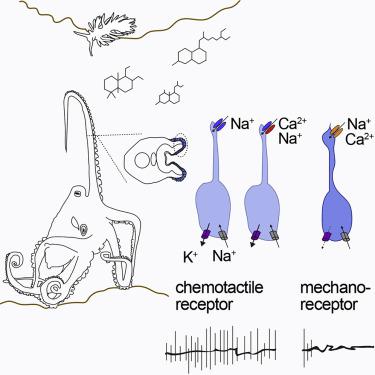Cell ( IF 64.5 ) Pub Date : 2020-10-29 , DOI: 10.1016/j.cell.2020.09.008 Lena van Giesen 1 , Peter B Kilian 1 , Corey A H Allard 1 , Nicholas W Bellono 1

|
Animals display wide-ranging evolutionary adaptations based on their ecological niche. Octopuses explore the seafloor with their flexible arms using a specialized “taste by touch” system to locally sense and respond to prey-derived chemicals and movement. How the peripherally distributed octopus nervous system mediates relatively autonomous arm behavior is unknown. Here, we report that octopus arms use a family of cephalopod-specific chemotactile receptors (CRs) to detect poorly soluble natural products, thereby defining a form of contact-dependent, aquatic chemosensation. CRs form discrete ion channel complexes that mediate the detection of diverse stimuli and transduction of specific ionic signals. Furthermore, distinct chemo- and mechanosensory cells exhibit specific receptor expression and electrical activities to support peripheral information coding and complex chemotactile behaviors. These findings demonstrate that the peripherally distributed octopus nervous system is a key site for signal processing and highlight how molecular and anatomical features synergistically evolve to suit an animal’s environmental context.
中文翻译:

章鱼化学触觉的分子基础
动物根据其生态位表现出广泛的进化适应性。章鱼用灵活的手臂探索海底,使用专门的“触觉味觉”系统来局部感知和响应猎物衍生的化学物质和运动。外周分布的章鱼神经系统如何调节相对自主的手臂行为尚不清楚。在这里,我们报告章鱼臂使用头足类特异性化学触觉受体 (CRs) 家族来检测难溶性天然产物,从而定义一种依赖于接触的水生化学感觉。CRs 形成离散的离子通道复合物,介导不同刺激的检测和特定离子信号的转导。此外,不同的化学和机械感应细胞表现出特定的受体表达和电活动,以支持外周信息编码和复杂的化学触觉行为。这些发现表明,外周分布的章鱼神经系统是信号处理的关键部位,并突出了分子和解剖特征如何协同进化以适应动物的环境背景。



























 京公网安备 11010802027423号
京公网安备 11010802027423号